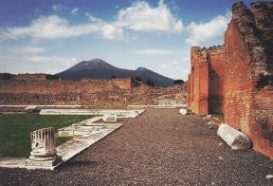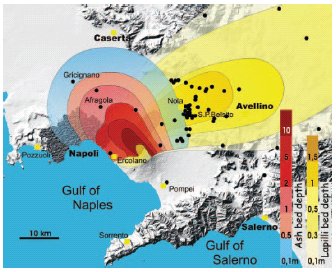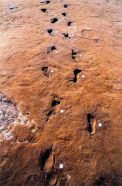A Volcano’s Deadly Ash
The discovery of long-buried skeletons and footprints suggests that a volcano could destroy Naples, Italy.
Share this:
- Share via email (Opens in new window) Email
- Click to share on Facebook (Opens in new window) Facebook
- Click to share on X (Opens in new window) X
- Click to share on Pinterest (Opens in new window) Pinterest
- Click to share on Reddit (Opens in new window) Reddit
- Share to Google Classroom (Opens in new window) Google Classroom
- Click to print (Opens in new window) Print
Every few hundred years, a sleeping giant in southern Italy awakens with a bang, spewing volcanic ash across the countryside.
The volcano, called Mount Vesuvius, formed 25,000 years ago. During its most explosive eruptions, the volcano could blanket nearby cities with hot ash, sometimes also burying them with deadly flows of mud and rocks.
 |
|
Mount Vesuvius, as seen from the ruins of Pompeii in southern Italy. |
| Wikipedia |
One famous eruption occurred nearly 2,000 years ago, in the year 79 A.D. The blast lasted 18 hours and destroyed the Roman cities of Pompeii and Herculaneum, killing thousands of people as they tried to escape.
Scientists and city officials had supposed that Naples, one of Italy’s most populous cities, was far enough away that it would be safe from the volcano’s wrath. New evidence suggests that this might not be the case.
 |
|
This map of a portion of southern Italy shows how ash from Mount Vesuvius could spread as far as the city of Naples (Napoli). |
| Proceedings of the National Academy of Sciences |
Researchers recently discovered 4000-year-old layers of ash and mud under present-day Naples. Just outside the city, they also uncovered abandoned villages, as well as human and animal skeletons.
Most surprising of all, the researchers say, was the discovery of thousands of footprints from the same time period, pressed into layers of wet ash that had rained from the sky. The footprints show that thousands of people were fleeing to the northwest, away from the volcano, as it erupted.
 |
|
Footprints, preserved in ash deposits, show that thousands of people fled an eruption at Mount Vesuvius 3,780 years ago. |
| Proceedings of the National Academy of Sciences |
Mount Vesuvius hasn’t had a major eruption since 1631, but it’s still very active. And the discovery of the ancient ash layers, skeletons, and footprints are a warning that modern Naples, a city of 3 million people, isn’t safe from the volcano after all, scientists say.
So, when the volcano begins to rumble again, Naples should have an emergency evacuation plan ready—just in case.—C. Gramling
Going Deeper:
Gramling, Carolyn. 2006. Vesuvius’ shadow: A major volcanic blast could threaten Naples. Science News 169(March 11):150. Available at http://www.sciencenews.org/articles/20060311/fob8.asp .
You can find out more about Mount Vesuvius and the eruption that buried Pompeii at en.wikipedia.org/wiki/Pompeii (Wikipedia) and www.cotf.edu/ete/modules/volcanoes/vmtvesuvius.html (Wheeling Jesuit University).






